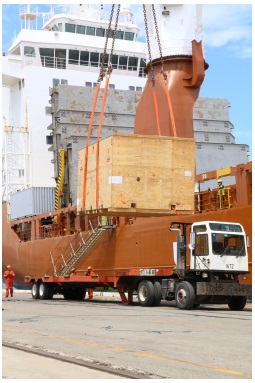Cargo Operations: Jacksonville, Oakland
![]() Print this Article | Send to Colleague
Print this Article | Send to Colleague
The machinery, which is worth more than $2 million, was manufactured in Germany and shipped from Belgium to JAXPORT in a wooden crate aboard the Spliethoff general cargo vessel Dynamogracht.
The stevedores involved in the operation are experienced in the movement of specialty, heavy-lift cargo and are employed by JAXPORT tenant Seaonus. The equipment will be trucked to destination by an 11-axle tractor trailer.
Talleyrand Marine Terminal offers 4,780 linear feet of berth space and is conveniently located near three U.S.
interstates, I-10, I-95 and I-75. Jacksonville’s skilled workforce offers a variety of labor options, including master riggers specializing in heavy lift and project cargo.

Longshoremen guide crated generator as it is lowered onto truck from M/V Dynamogracht
Photo/JAXPORT
Port of Oakland Anticipates Smooth Peak Season
Possible record peak-season import volume should flow smoothly through the Port of Oakland, says the port’s maritime director, John Driscoll.
"We’re hearing that the next two-to-three months could set new containerized import records in the U.S.," Mr. Driscoll said. "If that’s the case, we’re ready; we’ve got plenty of equipment to move cargo and our terminals are operating with high efficiency."
Mr. Driscoll’s comments followed a bullish forecast by the National Retail Federation that containerized imports could reach record highs in July and August the traditional start of peak season when retailers stock up for back-to-school and holiday sales.
Underscoring the prediction, Oakland reported record cargo volume for the month of June, with imports alone up 3.4 percent compared to June 2016. The port expects the trend to continue for the next few months.
Here’s the port summary of peak-season preparedness:
- Marine terminals are loading and unloading ships with a 24-hour average turnaround.
- They’re requiring appointments for truck drivers to pick up import containers, easing crowding at terminal gates.
- Night gates are also improving cargo flow. Oakland International Container Terminal (OICT) is processing about 1,200 transactions a night, roughly 20 percent of its daily volume.
- An exclusive, off-terminal empty container yard is helping to smooth out traffic, too. OICT reports about 400 empty pick-ups/deliveries every day.
- Truck drivers require only 30-to-90 minutes in most cases to pick up or deliver cargo.
- Occasional truck queues at TraPac marine terminal should thin out by September when a new gate complex opens.
- There’s no shortage of containers to ship exports out of Oakland.
- Leasing companies report an adequate supply of chassis, which are essential for hauling containers over the road. The providers are working daily with marine terminals to reposition chassis when peak-period supplies are tight.

